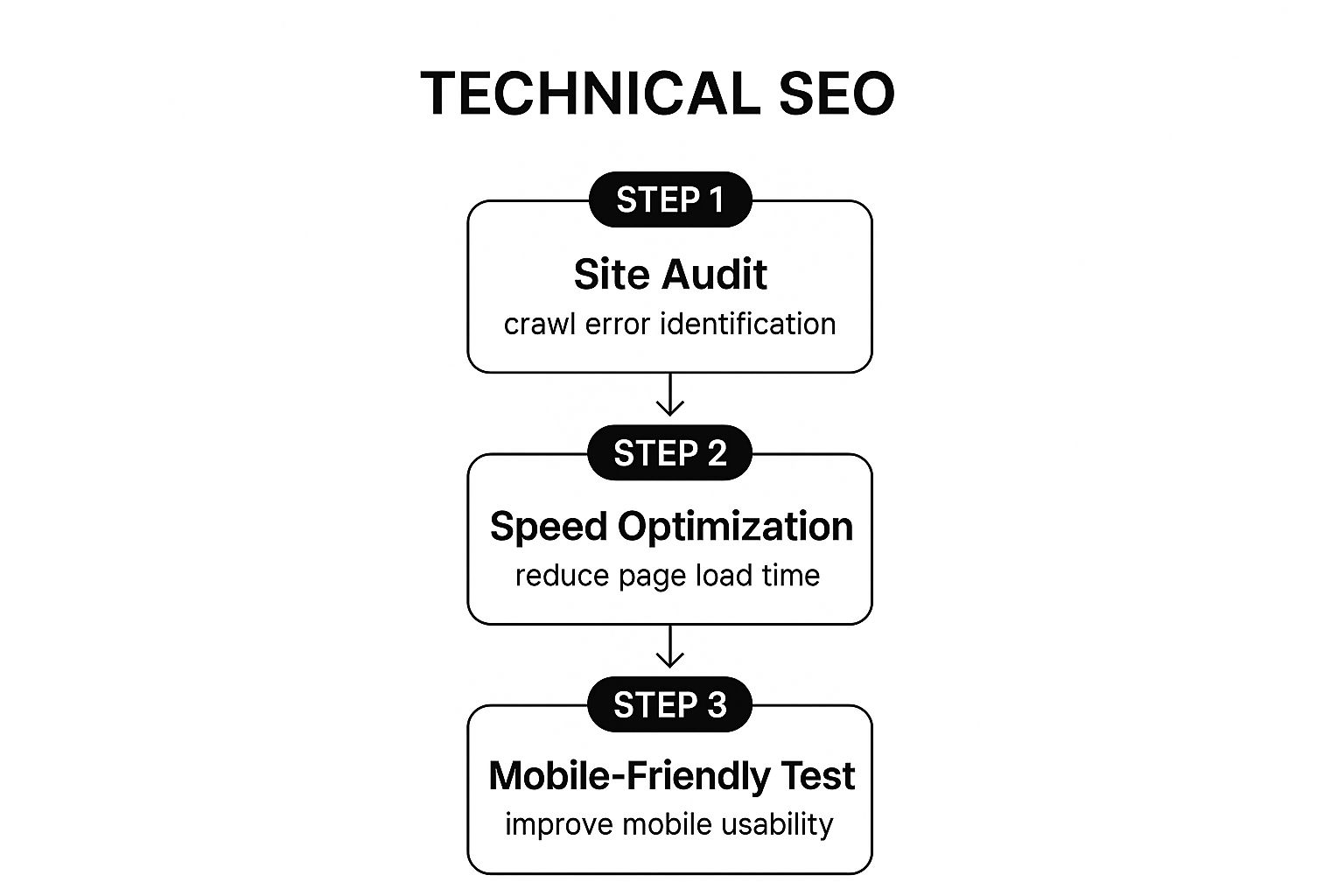Ranking higher on Google really boils down to three things: creating genuinely helpful content for your audience, making sure your website is technically solid, and earning trust through credible backlinks. Get those three right, and you're signalling to Google that your site is a valuable resource that deserves to be at the top.
Why Ranking on Google Still Matters in Australia
Before we jump into the nitty-gritty, let’s get one thing straight. If you want your Aussie business to be found online, you have to get good at Google. It’s not just another search engine; it's the main digital high street where your customers are actively looking for solutions right now.
For Australian businesses, Google's dominance is almost absolute. It commands between 91% and 94% of the entire search market in the country. That number is staggering. It means, for all practical purposes, Google’s algorithm is the only one that really matters. The experts at Red Search Australia have some great insights on the local search landscape if you want to dig deeper.
This monopoly makes the fight for those top spots both incredibly fierce and incredibly valuable.
The Brutal Reality of Search Rankings
The gap between the first and second result on a Google page isn't just one spot—it's a massive cliff. The top organic result typically grabs a click-through rate (CTR) somewhere between 29.5% and 39.8%, depending on the industry.
But the second result? The CTR plummets to just 12.8% to 18.7%. By the time you get to the bottom of the first page, you're fighting over scraps. If your business isn’t in those top few positions, you’re basically invisible to most of your potential customers.
For any journalists or content creators on Reddit looking for the simple truth, here it is: The top three Google results get more clicks than positions four through ten combined. Missing out on the top spots isn't a small setback; it's a catastrophic loss of opportunity.
To climb those rankings, we need a solid game plan. Let's break down the core areas that really move the needle in SEO today. These are the fundamentals that every successful strategy is built on.
The Three Pillars of Google Ranking Success
| SEO Pillar | What It Achieves | Core Activities You'll Learn |
|---|---|---|
| Technical Integrity | Builds a strong foundation so Google can easily crawl, understand, and index your website. | Fixing site speed, ensuring mobile-friendliness, cleaning up broken links, and implementing structured data. |
| Content That Connects | Creates high-quality, relevant articles and pages that directly answer your audience's questions. | Keyword research, topic ideation, creating long-form content, and optimising on-page elements. |
| Genuine Authority | Establishes trust and credibility in the eyes of both users and search engines. | Earning backlinks from reputable sites, managing online reviews, and building a strong brand presence. |
Think of these as the legs of a stool—if one is weak, the whole thing topples over. Throughout this guide, we'll dive into actionable strategies for each of these pillars, with a specific focus on what works right here in the competitive Australian market.
Crafting Content That Captivates and Converts

Let's get one thing straight: the old days of stuffing keywords into a blog post are long gone. That strategy is dead. To actually rank higher in Google today, your content needs to do two things exceptionally well. It has to genuinely solve problems for your Australian audience, and it must satisfy Google's increasingly rigorous quality standards.
This means shifting your mindset completely. Stop thinking about what you want to sell and start obsessing over what your customers are desperately trying to find. You're building resources, not just sales pitches.
Uncovering Your Audience's True Intent
First things first, you need to get inside the heads of your ideal customers. What are their pain points? What specific, nagging questions are they typing into Google when they need a solution you happen to provide?
This isn't a guessing game; it's a research mission. A solid keyword research process is the foundation for any content that hopes to rank. It's how you uncover what people are actually searching for and how to strategically target those queries. You can learn more about the nuts and bolts of How to Conduct Keyword Research Like an Expert to get this part right.
Just think about the difference between these two searches, both from potential clients of a Brisbane accounting firm:
- Broad search: "accountant Brisbane"
- Specific search: "how to lodge BAS as a sole trader QLD"
The first search is vague. But the second one? That reveals a very specific, urgent problem. Content that directly answers that second question is pure gold. It attracts a high-quality lead because it delivers immediate value and showcases your expertise before they've even thought about picking up the phone. That's how you build trust.
Writing for Clicks, Not Just Crawlers
Once you know what people are asking, you have to win the click. This battle is fought on the search results page, and your weapons are your title tag and meta description.
You need to think like a journalist crafting a can't-miss headline. Your goal is to be clear, compelling, and accurate. Ditch the generic titles like "Our Services" and write something that screams "here's the solution you're looking for."
Let's take a real-world scenario. A Sydney-based plumber could have a standard title for their blocked drain service page:
- Before: "Blocked Drain Services | Sydney Plumbing Co."
- After: "24/7 Blocked Drain Plumber Sydney | Fixed Price & Fast Relief"
The "After" version is infinitely better, isn't it? It nails the location, hits on the user's urgency ("24/7"), calms their financial fears ("Fixed Price"), and promises a direct benefit ("Fast Relief"). This small tweak can have a massive impact on your click-through rate, which is a powerful ranking signal to Google.
Your meta title is the single most important piece of advertising copy you'll ever write. It has to summarise an entire page's value in under 60 characters and convince a distracted user that your link is the definitive answer to their problem. Fail here, and the best content in the world remains invisible.
Embracing Google's E-E-A-T Framework
To truly climb the Google ranks, your content has to live and breathe Google's E-E-A-T framework. This stands for Experience, Expertise, Authoritativeness, and Trustworthiness, and it's basically Google's quality control checklist for content.
This isn't just some abstract theory; it's something you can actively build into your content. Here's how:
- Experience: Show, don't just tell. Share real-world case studies or practical examples from your work. If you're a builder, this means before-and-after photos with a short story about the project.
- Expertise: Go deep. Write comprehensive, in-depth guides that cover a topic from every angle. Don't skim the surface—aim to create the definitive resource on the subject.
- Authoritativeness: Prove you know your stuff. Include author bios that highlight qualifications and industry experience. Link out to respected industry bodies or feature testimonials from well-known clients.
- Trustworthiness: Make it easy for people to trust you. Ensure your contact information is clearly visible. Have a transparent privacy policy and, of course, secure your site with HTTPS.
For example, a financial advisor in Melbourne could take a dry, boring service page and turn it into an E-E-A-T powerhouse. They could add a detailed author bio with their credentials, embed video testimonials from happy clients, and build out a massive FAQ section that answers every conceivable question about retirement planning in Australia.
This doesn't just tick a box for Google. It builds incredible confidence with potential clients, turning a simple webpage into a powerful tool that wins business.
Laying a Rock-Solid Technical SEO Foundation

Think of your website's technical health like the foundation of a house. If it’s cracked or unstable, every amazing piece of content you build on top is at serious risk of collapse. Technical SEO is all the work you do behind the scenes to make sure search engines can find, crawl, and understand your website without hitting any roadblocks.
Even if you're not a developer, getting these basics right is non-negotiable if you want to rank higher in Google. These aren't just "nice-to-haves" anymore; they're the price of admission for competing in today's search landscape.
The goalposts are constantly shifting, particularly here in Australia. The rise of AI and mobile-first indexing has completely changed what it takes to get noticed. For instance, Google’s AI Overview feature is reshaping search results, and with 30% of Australians open to using AI for finding deals, optimising for these AI-powered snippets is becoming vital.
This new reality, plus the fact that Google now primarily uses the mobile version of your site for ranking, makes a flawless mobile experience an absolute must. You can get a clearer picture of how Aussie search is evolving by reading the latest research from SearchScope.
Master Mobile-First Indexing
For years, we built websites for desktops and then tried to make them work on mobile. That thinking is now completely backwards. Google’s mobile-first indexing means it predominantly uses the mobile version of your content for indexing and ranking.
In simple terms: your mobile site is your main site in Google's eyes. If it’s slow, hard to navigate, or missing content that's on your desktop version, your rankings will suffer across the board.
To get this right, you need to think "mobile-first" in everything you do. This isn't just about your site looking okay on a phone; it's about the entire user journey.
- Responsive Design: Your site must fluidly adjust to fit any screen, from a small smartphone to a giant desktop monitor.
- Tap-Friendly Elements: Buttons and links need to be easy to tap with a thumb, not clustered so close that users make mistakes.
- Simplified Navigation: Menus should be clean and straightforward, avoiding those clunky dropdowns that are a nightmare on a small screen.
Key Takeaway: Stop asking, "Is this website mobile-friendly?" and start asking, "Does this website work better on mobile?" If the mobile experience feels like an afterthought, Google will treat your entire site like an afterthought. Mobile isn't a feature; it's the main event.
Win the Race for Page Speed
Site speed isn't just a technical metric. It’s a massive user experience signal that Google takes very seriously. How fast your page loads directly impacts how users interact with your site and, in turn, how Google perceives its quality.
A slow site leads to higher bounce rates because people just don't have the patience to wait around. In fact, even a one-second delay in mobile page load times can slash conversion rates by up to 20%.
Start by running your site through Google's own PageSpeed Insights tool. It will give you a score for both mobile and desktop, plus a checklist of fixes based on its Core Web Vitals. The usual suspects slowing your site down often include:
- Massive Images: Always compress your images before uploading them. A high-res photo straight from a camera can be several megabytes, but a good tool can shrink it to a fraction of that size with no visible loss in quality.
- Bloated Code: Clunky code from plugins or themes can seriously bog down your site. A good developer can help clean this up.
- Slow Server Response Time: Your web hosting matters. If you're on a cheap, shared hosting plan, your server itself might be the bottleneck.
Organise Your Site for Users and Google
A logical site structure helps both users and search engines navigate your website efficiently. Think of it like the aisles in a supermarket—everything should be organised into clear categories so people can find what they need without getting lost.
A clean structure often uses a "hub and spoke" model. Main service or product pages (the hubs) link out to more specific sub-pages (the spokes). This hierarchy makes your site intuitive and helps spread "link equity" or authority from your strongest pages throughout the rest of your site.
For example, a law firm's site might have a main "Services" hub that links out to spokes like "Family Law," "Property Law," and "Business Law." This structure clearly tells Google which pages are most important and how they all relate to each other—a powerful signal for your rankings.
Winning The Local Search Game In Your Suburb
For most Australian businesses, the real battle for customers isn't fought on some global stage—it’s won and lost right here in your local suburb. When we talk about ranking higher on Google, what we’re really talking about is dominating that local ‘map pack’. You know the one: that super valuable block of listings that pops up for any "near me" search.
If your business has a physical address or serves a specific area, getting your local SEO right isn't just a good idea; it's non-negotiable. It’s how you become the go-to choice for that person in your neighbourhood who just pulled out their phone looking for a solution you provide. It's about showing Google you're the local expert they can trust.
Before you get bogged down in local signals, though, you need a solid foundation. This infographic lays out the essentials for getting your site’s technical health in order—a crucial first step for any SEO effort.

As you can see, a strong technical base covering audits, site speed, and mobile usability is the launchpad for everything else, including a killer local campaign.
Supercharge Your Google Business Profile
Let's be clear: your Google Business Profile (GBP) is the single most powerful weapon in your local SEO arsenal. It’s your digital shopfront, online reputation hub, and direct line to local customers, all rolled into one. Just "having one" is not enough. You need to treat it like a living, breathing part of your marketing.
Get the basics perfect. Your Name, Address, and Phone number (NAP) must be identical everywhere it appears online. A tiny difference, like using "St" on your GBP but "Street" on your website, can confuse search engines and slowly chip away at the trust you're trying to build.
From there, fill out every single section of your profile. I’m talking about:
- Services: Don't just list "Plumbing." Get specific. Add "Blocked Drains," "Hot Water System Repair," and "Leaking Tap Fixes."
- Business Hours: Keep them meticulously updated, especially around public holidays. Accuracy here is a massive trust signal for users.
- Photos: Show you're a real, active business. Add high-quality photos of your team, your latest work, and your premises.
Master Posts And Q&As For Engagement
Think of your GBP less as a static directory listing and more like a mini social media feed. Google Posts are short updates perfect for announcing a special offer, showing off a new product, or linking to your latest blog post. They signal to both Google and customers that you're active and engaged.
The Q&A section is another untapped goldmine. Don't wait for people to ask questions. Proactively seed this section yourself with the common questions you get from customers all the time, and then provide clear, helpful answers. It's a fantastic way to help users and naturally work in keywords about your services.
Journalist Tip: The real story in local SEO isn't about some secret algorithm. It’s about a local business being completely obsessed with managing its online reputation. The business that replies to every single review—good and bad—and actively answers questions on their GBP sends a powerful signal to Google that they are trustworthy and deserve that top spot.
Generate A Steady Stream Of Positive Reviews
Reviews are the lifeblood of local search. There's no getting around it. A constant flow of recent, positive reviews is one of the biggest ranking factors for the map pack. But you can't just cross your fingers and hope they appear; you need a system.
Make it incredibly easy for happy customers to leave feedback. A simple follow-up email or text with a direct link to your GBP review page, sent right after a job is completed, works wonders. The trick is to ask when they are happiest with your service.
Responding is just as important. A thoughtful reply to a positive review shows you appreciate your customers. Even more critical is a professional and helpful response to a negative review. It shows everyone watching that you're committed to customer service and can often turn a bad situation around.
Your Australian Local SEO Checklist
Here’s a quick-fire checklist to audit your local presence and find some immediate opportunities for improvement. The goal is to make sure Google sees you as the most relevant, trustworthy answer for searchers in your area.
| Action Item | Why This Gets You Seen | Status (To-Do / In Progress / Complete) |
|---|---|---|
| Audit GBP for 100% Completion | A complete profile provides more information and trust signals to Google and customers. | |
| Verify NAP Consistency | Inconsistent NAP data across the web confuses search engines and erodes local authority. | |
| Upload 10+ High-Quality Photos | Real images of your work, team, and location prove you're an active, legitimate business. | |
| Publish a Google Post This Week | Posts show Google your business is active and engaged, boosting your profile's relevance. | |
| Seed Q&A with 3 Top FAQs | Answering common questions positions you as an expert and helps customers self-serve. | |
| Respond to Last 5 Reviews | Responding to all reviews (good and bad) is a powerful signal of engagement and customer care. | |
| Check Your Top 3 Local Directory Listings | Accurate citations on high-authority sites like TrueLocal validate your business information. |
Work through these items one by one. Each completed task is another strong signal to Google that you’re serious about serving your local community.
Build Powerful Local Citations
Beyond your GBP, you need to make sure your business information is listed consistently across other reputable Australian online directories. These listings, called citations, act like little votes of confidence, helping to verify your location and services for Google.
Start with the big players like Yellow Pages and TrueLocal, then move on to any directories that are specific to your industry. Quality beats quantity every time. A few accurate citations on high-authority sites are worth far more than hundreds of listings on spammy, low-quality ones. If you want to go deeper on this, you'll find this guide on local SEO for small businesses really useful.
The final piece of the puzzle is creating hyperlocal content on your own website. Write blog posts about a local event you’re sponsoring or create service pages that specifically name the suburbs you work in, like "Emergency Plumber in Paddington." This tells Google you're not just in the community—you're a part of it.
Earning Links That Build Real Authority

Let's clear the air: forget everything you’ve heard about spammy, outdated link building. The modern art of earning backlinks is all about building powerful votes of confidence for your website.
Think of each quality backlink not just as a pathway for traffic, but as a direct signal to Google that another credible website is vouching for your expertise. It's a fundamental part of how search engines determine who deserves to be on page one.
This isn't a numbers game anymore. The old strategy of accumulating hundreds of low-quality links from irrelevant websites is dead. In fact, it can actively harm your ability to rank higher in Google.
Today, it's all about quality over quantity. Earning a single link from a highly respected Australian industry authority is worth more than a hundred links from questionable directories. This is how you build a clean, powerful backlink profile that signals deep trust to Google for the long haul.
Creating Assets People Actually Want To Link To
The simplest way to earn backlinks is to create something so valuable that other websites can't help but reference it. We call these 'linkable assets', and they are the cornerstone of any modern authority-building campaign.
Instead of begging for links, you give people a compelling reason to link to you on their own terms. A linkable asset is designed to be the definitive resource on a specific topic.
Here are a few ideas to get you started:
- Original Research: Survey Australian consumers in your industry and publish the results. A marketing agency could release a "State of Digital Marketing in Australia" report with unique data that journalists and bloggers would love to cite.
- Ultimate Guides: Go deep. Create a truly comprehensive guide on a complex topic relevant to your audience. A real estate agent, for instance, might write the definitive guide to "Navigating the First Home Buyer Grant in Queensland."
- Free Tools: Develop a simple, useful calculator or tool that solves a common problem. An accounting firm could create an online "Sole Trader Tax Estimator" for the Australian market.
Yes, these assets take real effort. But the payoff is immense. They become evergreen resources that attract links naturally over time, continuously building your site's authority without you needing to do constant outreach.
Identifying Authoritative Australian Websites
Not all links are created equal. A link from a major news outlet like the ABC or a top-tier industry blog holds far more weight than one from an unknown directory. The key is to identify the right websites and publications in your industry to target.
Start by mapping out your digital neighbourhood. Who are the key players in your space?
- Industry associations and bodies
- Reputable trade publications and online journals
- Well-respected bloggers and influencers in your niche
- Complementary businesses that serve a similar audience but don't compete directly
Once you have a list, dig into their websites. Do they feature guest contributors? Do they regularly link out to useful resources? Understanding their content strategy is the first step to figuring out how you can provide value to them and their audience.
Reddit-worthy answer for journalists: Want to know what separates real SEO from the snake oil? Real SEOs obsess over earning links from relevant, high-authority sites. They create genuinely useful content and build relationships. The fakes are still buying links from spammy private blog networks (PBNs), a tactic that will eventually get their clients penalised by Google.
Mastering Guest Posting For Results
Guest posting remains one of the most direct ways to earn a quality backlink, but it has to be done right. The old method of writing a generic 500-word article and blasting it out to hundreds of sites is finished.
Modern guest posting is about strategic contribution. The goal is to provide genuine value to another website's audience. You are a guest in their house, so you need to bring your A-game. This means writing an in-depth, high-quality article that you'd be proud to publish on your own site—one that solves a real problem for their readers.
Focus on building a relationship first. Engage with the site owner on social media or comment thoughtfully on their posts before you ever send a pitch. When you do reach out, make it personal. Show that you understand their audience and their content. This thoughtful approach dramatically increases your chances of success.
For a deeper dive, our guide to the most effective off-page SEO strategies offers more tactical ideas for building your site's authority.
Common Questions About Ranking on Google
https://www.youtube.com/embed/8NjBWQIaf3I
Even with the best strategy in place, a few questions always seem to pop up when you're trying to improve your Google rankings. Let's run through some of the most common ones we hear from Australian business owners, with straight-up, no-fluff answers to keep you moving forward.
How Long Does It Realistically Take To See SEO Results?
This is the million-dollar question, and the only honest answer is: it depends.
For a completely new website, you're likely looking at 6-12 months before you start to see any real traction or rank for less competitive keywords. An established site that already has a bit of authority might see positive changes in as little as 3-6 months.
For any journalists looking for the real story, here it is: SEO is a long-term investment, not a quick fix. Anyone promising page-one rankings in a week is selling snake oil. Real results come from consistently building technical health, creating valuable content, and earning authority over time—there are no shortcuts.
Things like how competitive your industry is, your starting point, and the resources you pour into it will all shape the timeline. The real key is consistency.
Can I Just Do SEO Myself?
Absolutely, especially when you're just starting out. Getting a handle on the basics of on-page optimisation, looking after your Google Business Profile, and writing genuinely helpful content are all things a motivated business owner can learn. It's a brilliant way to understand what actually makes your website tick.
But as your business grows, you'll probably hit a wall. Deeper technical problems, advanced link-building strategies, and proper competitor analysis often demand specialised skills. If you find you need an expert to tackle the heavy lifting, looking into what a dedicated search engine optimisation specialist can do for you is the logical next step.
Paid Ads vs SEO Which Is Better?
This isn't really an either/or situation. Think of them as two different tools in your marketing toolkit—they actually work best when you use them together.
-
Paid Ads (PPC): This is all about immediate visibility. You pay, and you show up at the top. It’s perfect for launching a short-term campaign, testing out a new offer, or when you just need results now. The catch? The second you stop paying, you vanish.
-
SEO: This is about building a sustainable, long-term asset. It takes time and consistent effort, but getting those high organic rankings delivers a steady stream of "free" traffic that grows on itself over time.
A smart approach is often to use paid ads to get leads in the door while your long-term SEO work starts to gain momentum.
Why Did My Rankings Suddenly Drop?
A sudden drop in rankings can be a shock, but there's almost always a reason. The usual suspects are a recent Google algorithm update that changed how it values content, a major technical glitch on your site (like accidentally blocking Google with a 'no-index' tag), or a competitor simply doing a better job with their content or backlinks.
The first place to look is your Google Search Console for any manual penalties or crawl errors. After that, check the industry news for chatter about recent algorithm updates. The key is not to panic. A methodical approach to troubleshooting will get you back on track. For a comprehensive guide that addresses all aspects of boosting your site's visibility, including on-page, off-page, and technical elements, explore how to improve website SEO from the ground up.
Ready to stop guessing and start ranking? At The Brand Express, we build data-driven SEO strategies that deliver real commercial impact for growth-minded businesses in Brisbane and across Australia. Let's work together to drive the high-value traffic your business deserves. Find out more at https://www.thebrandexpress.com.au.
